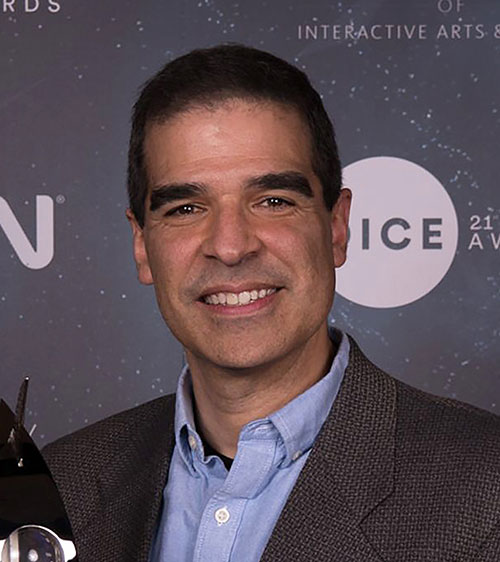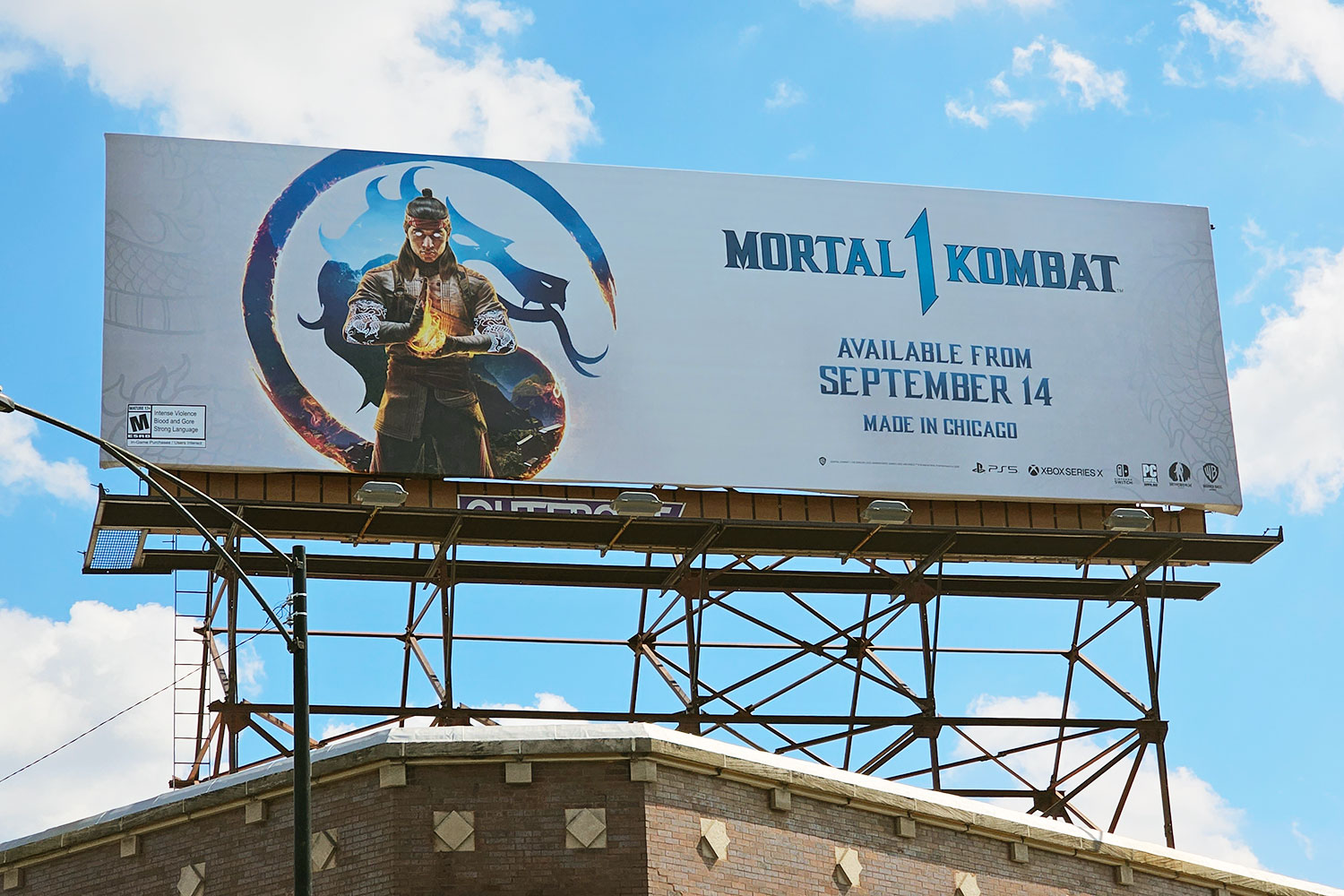If you were to ask Ed Boon what his morning routine looked like, you’d receive a relatively mundane answer: coffee and maybe some exercise. His love of golf and the occasional game of basketball don’t particularly raise an eyebrow either. At a glance, the average person probably wouldn’t guess that his work involves ripping out spines, brains, and still-beating hearts. Yet, the 59-year-old Chicagoan has been doing this for decades. Thankfully, those appendages are only virtual, but this type of gore and carnage is a common sight for the cocreator of one of the most beloved video game franchises in history: Mortal Kombat.
The bane of mid-’90s mothers everywhere, neither the series nor Boon are ready for a finale (or shall we say, ready for a “Finish him!” moment). With the release of Mortal Kombat 1 this month, Boon and NetherRealm Studios reboot the gruesome, twisted world of Mortal Kombat from the very beginning. Having also voiced the original incarnation of Mortal Kombat’s protagonist, Scorpion, Ed’s iconic “Get over here!” has seared its mark into the minds of millions — along with his games.

Describe your experience growing up in Chicago. Any favorite spots?
My parents are from the Dominican Republic. I’m the middle child of five siblings, so I was the first one to be born here in Chicago in the Rogers Park neighborhood. When I was in the third or fourth grade, we moved into the Skokie area. I still had a lot of family in the city, so we were constantly going back. There was a place called Herm’s Palace in Skokie, I believe it’s still here to this day. We used to play baseball and then go there afterwards. My best friend’s sister also worked at a Wendy’s, so we’d get a lot of free food from there all the time. Other than that, I enjoyed getting Slurpees and playing arcade games like Space Invaders at 7-Eleven.
When I went to college at the University of Illinois in Champaign about two hours away from the city, I often came back to Chicago for my summers. Those were the only two times I’ve lived outside of the city in my entire life.
Walk me through your history at NetherRealm. How did it all begin? What was the work culture like?
I’ve only ever made one resume, and it floated around to a company called Williams Electronics. I got a job there programming pinball machines. They were trying to get back into creating video games at the time, but they hadn’t started yet. A few years later, Williams purchased Bally Midway, who also made pinball games along with Pac-Man. They were working on a game called Arch Rivals, so we just got completely merged together, and they called us Midway Games. Eventually Midway Games spun off and started working on arcade and console games, including the original Mortal Kombat. Over time, we had some financial issues, to the point where we went bankrupt. Warner Brothers came and purchased our studio in 2009, and that was when we started making Mortal Kombat (a 2011 reboot now considered Mortal Kombat 9). That point signifies the transition from Midway to NetherRealm, where we’ve been for about 14 years.
A lot of people that work here are from the Chicago area. We actually make a big deal out of our Chicago heritage, to where we have billboards promoting Mortal Kombat 1 that say “Made in Chicago.” Even in our Williams Electronics days, everyone had this very Midwestern “roll up your sleeves and do the work” attitude about their jobs. When you’re around people who do that, it definitely rubs off on you. Everyone was very passionate about the games they worked on, but they were still very cooperative and team-oriented. To some extent, I think that attitude still remains here, 30 years later. We’ve always been down the street from Wrigley Field, so I’ve been taking Addison Street to work my entire life. I’ve never driven to another exit. It’s so ingrained in me that I think I could drive to work in my sleep if I ever needed to.
Were there any major influences that shaped your outlook on the games you created?
My most formative years were certainly in the ’80s, my high school and college years. I was 15 years old when a game called Defender came out. That alongside other arcade games like Pac-Man and Donkey Kong were some of the catalysts that got me into making games. I remember reading a video game magazine later in life about a guy named Eugene Jarvis, who was making games like Defender and Robotron in the same building that I was working in (for Williams Electronics). I certainly remember playing these games and being interested in how they were made, along with enjoying how fun they were. When I was in Champaign, I would schedule my classes around giving myself a break to play video games, like it was a necessary part of my day. It’s fair to say I was a big gamer.
What’s the intention behind restarting the Mortal Kombat universe with MK1?
For those who are counting, this is our 12th Mortal Kombat. And with each game, we introduced another big boss villain, who was even more powerful than the last. We came out with this character in Mortal Kombat 11 called Kronika, who was the keeper of time and pretty much the Supreme Being of the universe. We figured that after her, there are no more steps to take. It’s not like we could create someone that was even her boss.
The idea was that Liu Kang, who’s kind of like the Bruce Lee or Luke Skywalker of Mortal Kombat, ascended to godhood and decided to create a new universe entirely from scratch. The idea was to have this Big Bang event where we could take all of our original characters and give them brand new origin stories and new relationships with each other. Our naming conventions have been kind of all over the place up to this point with Mortal Kombat (2011), then going to Mortal Kombat X, and finally Mortal Kombat 11. The name Mortal Kombat 1 really demonstrates how we’re starting over from the beginning.
One of the most fun parts of every Mortal Kombat release is the unpredictability of the roster. What criteria do you use to determine if a fan-favorite character should return or sit out for a bit?
There’s a number of factors that come into play. To some extent, there are certain staple characters that will likely always be in a Mortal Kombat game — characters like Raiden, Liu Kang, Sub Zero, and Scorpion. But then again, there’s close to 100 characters that we’ve represented in MK at some point. We always launch with about 20 characters, so obviously there’s about 75 characters who don’t make the cut.
There are some really passionate and sometimes angry players who campaign nonstop to have their favorite character put into the game. Popularity is a big factor, but we also like to give characters a rest, so that they can be missed. It’s sort of like a “absence makes the heart grow fonder” kind of thing.
Let’s say there’s an emergency situation and we need a voice for Scorpion today. Do you think you could do the voice again?
I absolutely could. I’ve done it for over 30 years now. If you listen, you can kind of hear how my voice has changed over the years. Now it’s a little more raspy from age. Maybe I could pull out an older, grizzled Scorpion.



